Weihong Zhong
Cross-Lingual Text-Rich Visual Comprehension: An Information Theory Perspective
Dec 23, 2024



Abstract:Recent Large Vision-Language Models (LVLMs) have shown promising reasoning capabilities on text-rich images from charts, tables, and documents. However, the abundant text within such images may increase the model's sensitivity to language. This raises the need to evaluate LVLM performance on cross-lingual text-rich visual inputs, where the language in the image differs from the language of the instructions. To address this, we introduce XT-VQA (Cross-Lingual Text-Rich Visual Question Answering), a benchmark designed to assess how LVLMs handle language inconsistency between image text and questions. XT-VQA integrates five existing text-rich VQA datasets and a newly collected dataset, XPaperQA, covering diverse scenarios that require faithful recognition and comprehension of visual information despite language inconsistency. Our evaluation of prominent LVLMs on XT-VQA reveals a significant drop in performance for cross-lingual scenarios, even for models with multilingual capabilities. A mutual information analysis suggests that this performance gap stems from cross-lingual questions failing to adequately activate relevant visual information. To mitigate this issue, we propose MVCL-MI (Maximization of Vision-Language Cross-Lingual Mutual Information), where a visual-text cross-lingual alignment is built by maximizing mutual information between the model's outputs and visual information. This is achieved by distilling knowledge from monolingual to cross-lingual settings through KL divergence minimization, where monolingual output logits serve as a teacher. Experimental results on the XT-VQA demonstrate that MVCL-MI effectively reduces the visual-text cross-lingual performance disparity while preserving the inherent capabilities of LVLMs, shedding new light on the potential practice for improving LVLMs. Codes are available at: https://github.com/Stardust-y/XTVQA.git
Length Controlled Generation for Black-box LLMs
Dec 19, 2024



Abstract:Large language models (LLMs) have demonstrated impressive instruction following capabilities, while still struggling to accurately manage the length of the generated text, which is a fundamental requirement in many real-world applications. Existing length control methods involve fine-tuning the parameters of LLMs, which is inefficient and suboptimal for practical use. In this paper, we propose a novel iterative sampling framework for text length control, integrating the Metropolis-Hastings algorithm with an importance sampling acceleration strategy. This framework efficiently and reliably regulates LLMs to generate length-constrained text without modifying the underlying parameters, thereby preserving the original capabilities of LLMs. Experimental results demonstrate that our framework achieves almost 100\% success rates of length control on Llama3.1 for tasks such as length-controlled abstractive summarization and length-constrained instruction following, with minimal additional computational overhead. This also highlights the significant potential of our method for precise length control across a broader range of applications, without compromising the versatility of LLMs.
Discrete Modeling via Boundary Conditional Diffusion Processes
Oct 29, 2024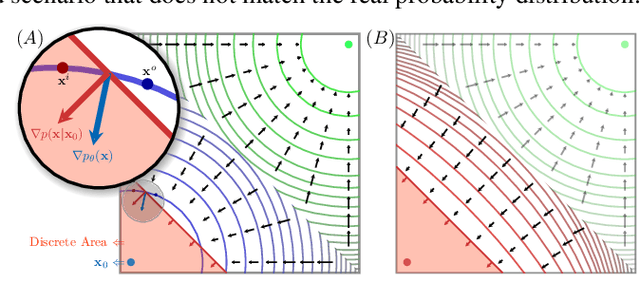


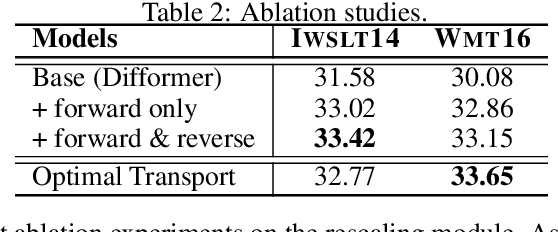
Abstract:We present an novel framework for efficiently and effectively extending the powerful continuous diffusion processes to discrete modeling. Previous approaches have suffered from the discrepancy between discrete data and continuous modeling. Our study reveals that the absence of guidance from discrete boundaries in learning probability contours is one of the main reasons. To address this issue, we propose a two-step forward process that first estimates the boundary as a prior distribution and then rescales the forward trajectory to construct a boundary conditional diffusion model. The reverse process is proportionally adjusted to guarantee that the learned contours yield more precise discrete data. Experimental results indicate that our approach achieves strong performance in both language modeling and discrete image generation tasks. In language modeling, our approach surpasses previous state-of-the-art continuous diffusion language models in three translation tasks and a summarization task, while also demonstrating competitive performance compared to auto-regressive transformers. Moreover, our method achieves comparable results to continuous diffusion models when using discrete ordinal pixels and establishes a new state-of-the-art for categorical image generation on the Cifar-10 dataset.
Advancing Large Language Model Attribution through Self-Improving
Oct 17, 2024
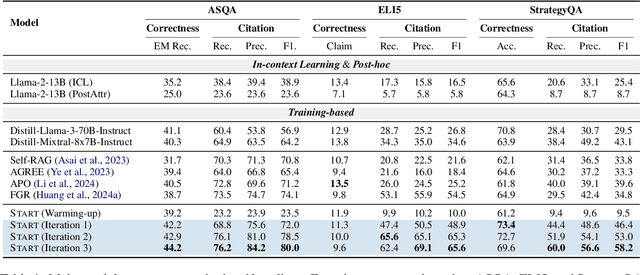
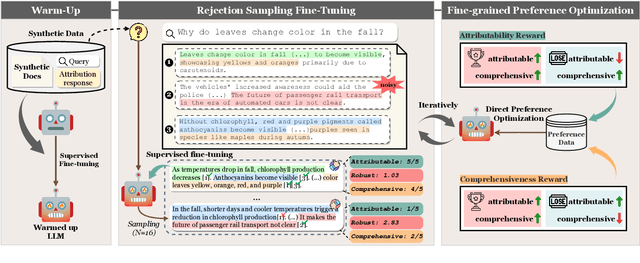

Abstract:Teaching large language models (LLMs) to generate text with citations to evidence sources can mitigate hallucinations and enhance verifiability in information-seeking systems. However, improving this capability requires high-quality attribution data, which is costly and labor-intensive. Inspired by recent advances in self-improvement that enhance LLMs without manual annotation, we present START, a Self-Taught AttRibuTion framework for iteratively improving the attribution capability of LLMs. First, to prevent models from stagnating due to initially insufficient supervision signals, START leverages the model to self-construct synthetic training data for warming up. To further self-improve the model's attribution ability, START iteratively utilizes fine-grained preference supervision signals constructed from its sampled responses to encourage robust, comprehensive, and attributable generation. Experiments on three open-domain question-answering datasets, covering long-form QA and multi-step reasoning, demonstrate significant performance gains of 25.13% on average without relying on human annotations and more advanced models. Further analysis reveals that START excels in aggregating information across multiple sources.
Learning Fine-Grained Grounded Citations for Attributed Large Language Models
Aug 08, 2024Abstract:Despite the impressive performance on information-seeking tasks, large language models (LLMs) still struggle with hallucinations. Attributed LLMs, which augment generated text with in-line citations, have shown potential in mitigating hallucinations and improving verifiability. However, current approaches suffer from suboptimal citation quality due to their reliance on in-context learning. Furthermore, the practice of citing only coarse document identifiers makes it challenging for users to perform fine-grained verification. In this work, we introduce FRONT, a training framework designed to teach LLMs to generate Fine-Grained Grounded Citations. By grounding model outputs in fine-grained supporting quotes, these quotes guide the generation of grounded and consistent responses, not only improving citation quality but also facilitating fine-grained verification. Experiments on the ALCE benchmark demonstrate the efficacy of FRONT in generating superior grounded responses and highly supportive citations. With LLaMA-2-7B, the framework significantly outperforms all the baselines, achieving an average of 14.21% improvement in citation quality across all datasets, even surpassing ChatGPT.
Investigating and Mitigating the Multimodal Hallucination Snowballing in Large Vision-Language Models
Jun 30, 2024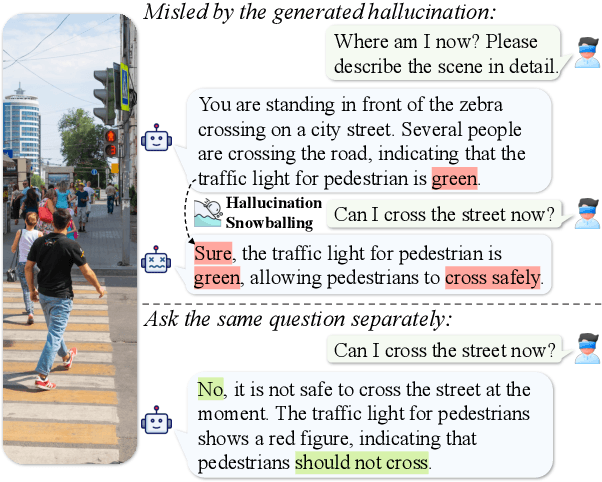
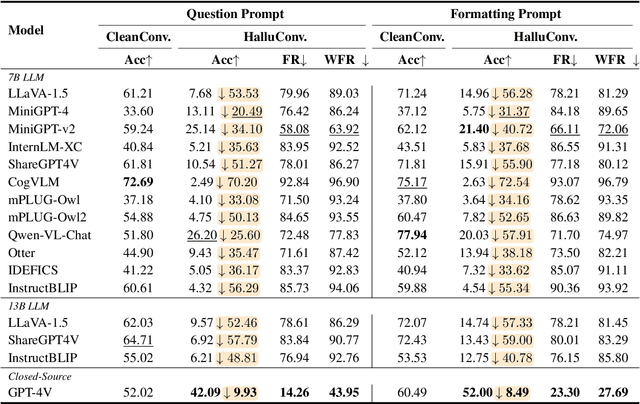
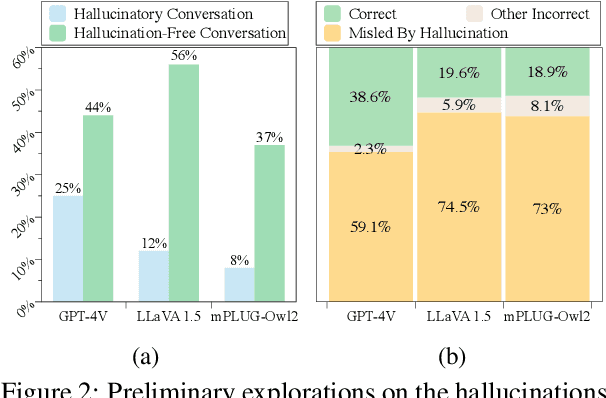
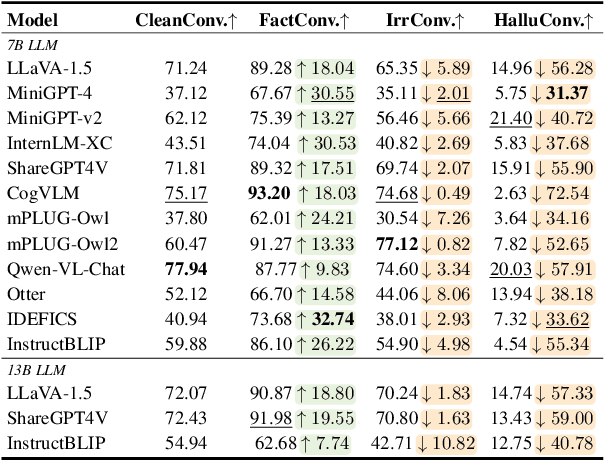
Abstract:Though advanced in understanding visual information with human languages, Large Vision-Language Models (LVLMs) still suffer from multimodal hallucinations. A natural concern is that during multimodal interaction, the generated hallucinations could influence the LVLMs' subsequent generation. Thus, we raise a question: When presented with a query relevant to the previously generated hallucination, will LVLMs be misled and respond incorrectly, even though the ground visual information exists? To answer this, we propose a framework called MMHalSnowball to evaluate LVLMs' behaviors when encountering generated hallucinations, where LVLMs are required to answer specific visual questions within a curated hallucinatory conversation. Crucially, our experiment shows that the performance of open-source LVLMs drops by at least $31\%$, indicating that LVLMs are prone to accept the generated hallucinations and make false claims that they would not have supported without distractions. We term this phenomenon Multimodal Hallucination Snowballing. To mitigate this, we further propose a training-free method called Residual Visual Decoding, where we revise the output distribution of LVLMs with the one derived from the residual visual input, providing models with direct access to the visual information. Experiments show that our method can mitigate more than $24\%$ of the snowballed multimodal hallucination while maintaining capabilities.
Rethinking Entity-level Unlearning for Large Language Models
Jun 22, 2024Abstract:Large language model unlearning has gained increasing attention due to its potential to mitigate security and privacy concerns. Current research predominantly focuses on Instance-level unlearning, specifically aiming at forgetting predefined instances of sensitive content. However, a notable gap still exists in exploring the deletion of complete entity-related information, which is crucial in many real-world scenarios, such as copyright protection. To this end, we propose a novel task of Entity-level unlearning, where the entity-related knowledge within the target model is supposed to be entirely erased. Given the challenge of practically accessing all entity-related knowledge within a model, we begin by simulating entity-level unlearning scenarios through fine-tuning models to introduce pseudo entities. Following this, we develop baseline methods inspired by trending unlearning techniques and conduct a detailed comparison of their effectiveness in this task. Extensive experiments reveal that current unlearning algorithms struggle to achieve effective entity-level unlearning. Additionally, our analyses further indicate that entity-related knowledge injected through fine-tuning is more susceptible than original entities from pre-training during unlearning, highlighting the necessity for more thorough pseudo-entity injection methods to make them closer to pre-trained knowledge.
A visualization method for data domain changes in CNN networks and the optimization method for selecting thresholds in classification tasks
Apr 19, 2024Abstract:In recent years, Face Anti-Spoofing (FAS) has played a crucial role in preserving the security of face recognition technology. With the rise of counterfeit face generation techniques, the challenge posed by digitally edited faces to face anti-spoofing is escalating. Existing FAS technologies primarily focus on intercepting physically forged faces and lack a robust solution for cross-domain FAS challenges. Moreover, determining an appropriate threshold to achieve optimal deployment results remains an issue for intra-domain FAS. To address these issues, we propose a visualization method that intuitively reflects the training outcomes of models by visualizing the prediction results on datasets. Additionally, we demonstrate that employing data augmentation techniques, such as downsampling and Gaussian blur, can effectively enhance performance on cross-domain tasks. Building upon our data visualization approach, we also introduce a methodology for setting threshold values based on the distribution of the training dataset. Ultimately, our methods secured us second place in both the Unified Physical-Digital Face Attack Detection competition and the Snapshot Spectral Imaging Face Anti-spoofing contest. The training code is available at https://github.com/SeaRecluse/CVPRW2024.
A Survey on Hallucination in Large Language Models: Principles, Taxonomy, Challenges, and Open Questions
Nov 09, 2023Abstract:The emergence of large language models (LLMs) has marked a significant breakthrough in natural language processing (NLP), leading to remarkable advancements in text understanding and generation. Nevertheless, alongside these strides, LLMs exhibit a critical tendency to produce hallucinations, resulting in content that is inconsistent with real-world facts or user inputs. This phenomenon poses substantial challenges to their practical deployment and raises concerns over the reliability of LLMs in real-world scenarios, which attracts increasing attention to detect and mitigate these hallucinations. In this survey, we aim to provide a thorough and in-depth overview of recent advances in the field of LLM hallucinations. We begin with an innovative taxonomy of LLM hallucinations, then delve into the factors contributing to hallucinations. Subsequently, we present a comprehensive overview of hallucination detection methods and benchmarks. Additionally, representative approaches designed to mitigate hallucinations are introduced accordingly. Finally, we analyze the challenges that highlight the current limitations and formulate open questions, aiming to delineate pathways for future research on hallucinations in LLMs.
STOA-VLP: Spatial-Temporal Modeling of Object and Action for Video-Language Pre-training
Feb 20, 2023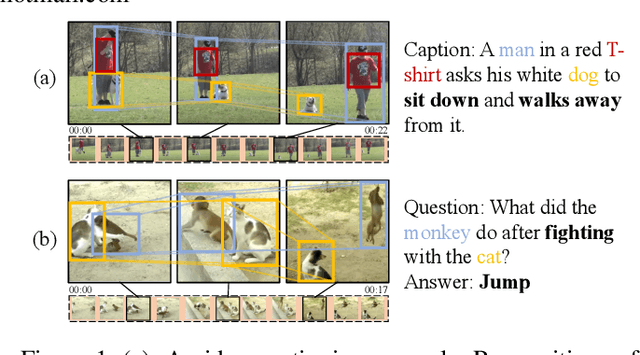
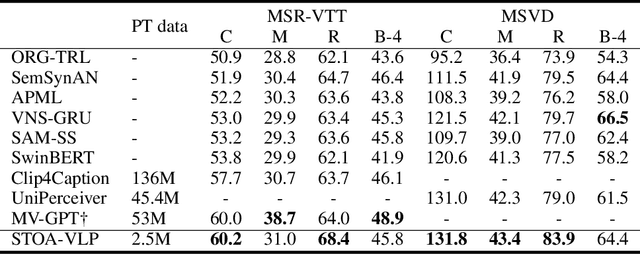

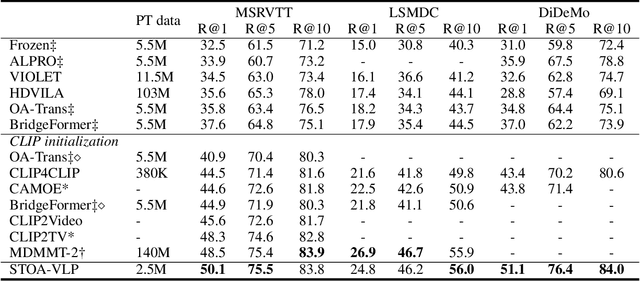
Abstract:Although large-scale video-language pre-training models, which usually build a global alignment between the video and the text, have achieved remarkable progress on various downstream tasks, the idea of adopting fine-grained information during the pre-training stage is not well explored. In this work, we propose STOA-VLP, a pre-training framework that jointly models object and action information across spatial and temporal dimensions. More specifically, the model regards object trajectories across frames and multiple action features from the video as fine-grained features. Besides, We design two auxiliary tasks to better incorporate both kinds of information into the pre-training process of the video-language model. The first is the dynamic object-text alignment task, which builds a better connection between object trajectories and the relevant noun tokens. The second is the spatial-temporal action set prediction, which guides the model to generate consistent action features by predicting actions found in the text. Extensive experiments on three downstream tasks (video captioning, text-video retrieval, and video question answering) demonstrate the effectiveness of our proposed STOA-VLP (e.g. 3.7 Rouge-L improvements on MSR-VTT video captioning benchmark, 2.9% accuracy improvements on MSVD video question answering benchmark, compared to previous approaches).
 Add to Chrome
Add to Chrome Add to Firefox
Add to Firefox Add to Edge
Add to Edge